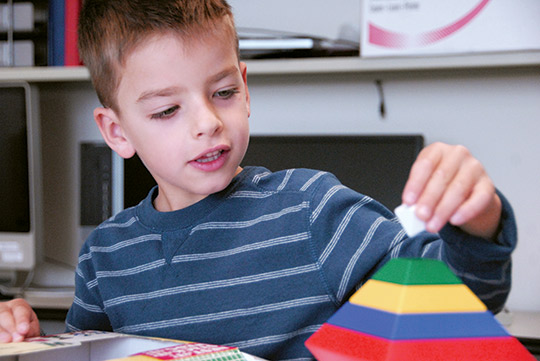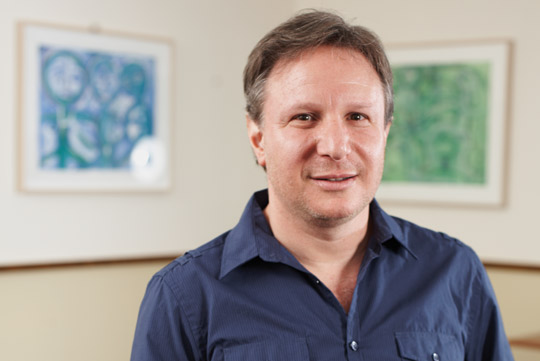Playing The Strong Hand
Andy Gordon created a therapy for children with cerebral palsy that draws on their strengths. Now he’s showing how it works in the brain.
By JOE LEVINE
HOW DO WE KNOW HOW TO PICK THINGS UP?
It’s not something most of us wonder about, but Andrew Gordon has spent much of his career pondering the question. His insights have enabled thousands of children with cerebral palsy to live more active lives, and his work could ultimately help patients who suffer from neurological disorders, such as Parkinson’s, or who need a prosthetic hand.
Gordon, Professor of Movement Sciences and Director of TC’s Center for Cerebral Palsy Research, has worked from the outside in. He began 25 years ago with observations of kids doing simple hand exercises, and his current efforts to map new or restored brain circuitry result from the therapies he has developed.
Most of Gordon’s work has centered on children with hemiplegia, a severe weakness in the limbs resulting in very low dexterity on the affected side of the body. When he was in graduate school in the late 1980s, such children weren’t expected to benefit much from physical rehabilitation, because it was believed they could not learn from experience — or “extract sensory information” — when trying to grip with an affected hand.
“The general consensus was that this kind of impairment didn’t get better, but I just didn’t believe it,” Gordon says. “I had worked with these kids and seen their hand movement improve after just half an hour in the lab.” The key, Gordon found, was lots of practice. When kids just kept trying to grip or lift something, eventually they got the hang of it.
Gordon became an early proponent of constraint-induced movement therapy, which successfully employs restraint of a patient’s healthy arm to force the patient to use the weaker limb. Gordon adapted the treatment to be child-friendly, restraining the healthy limb in a comfortable cotton sling rather than the traditional rigid cast. Yet by 2004 he had become disenchanted with the technique on several counts.
His starting point was the simple but incontrovertible fact that “in real life, these children have the use of both their hands.” Gordon and his team were also steadily amassing evidence that the better hand had a critically important role to play.
“We were finding that in kids with hemiplegia, the good hand can inform the bad hand. The brain can transfer the sensory information extracted by the good hand to literally provide the other hand with a template for performance.”
In other words, lifting something with the good hand first makes it much easier to then lift it with the weaker hand. With that as his guiding premise, Gordon and his students developed HABIT (hand-arm bimanual intensive therapy), which has since demonstrated added benefit over constraint-induced therapy by improving the coordination of both hands together.
Variations of HABIT are now widely used in clinics and rehab centers. Parents line up each summer to send their children to the therapeutic day camp Gordon runs in Thorndike Hall. Recently he and student Claudio Ferre created a home teaching kit that can be used with children as young as two. He has expanded treatment to include children who have hemiplegia due to surgical treatment of epilepsy. Perhaps most exciting of all, along with researchers from Belgium and the Netherlands, he and two stu¬dents, Bhavini Surana and Alexis Sidiropoulos, are targeting lower-extremity rehabilitation in children with more severe (bilateral) forms of cerebral palsy. The approach emphasizes increasing the intensity of motor learning-based rehabilitation training. Speaking at major con¬ferences, Gordon has delivered keynote addresses about this work, which could potentially help wheelchair-bound people take their first steps.
But Gordon, who was recently named an Active Fellow in the National Academy of Kinesiology, believes he is only beginning to tap into the real potential of his work. He has long understood that the successful rehab of kids with cerebral palsy provides evidence of neuroplasticity — the generation of new activation patterns in the brain. Only with the advent of recent technologies, however, has he been able to show precisely where and how powerful new connections are being formed. Using a tool called transcranial magnetic stimulation (TMS) to study children with hemiplegia who have received HABIT, Gordon, along with Kathleen Friel, of Burke-Cornell Medical Research Institute, TC student Cherie Kuo and postdoc Ana Smoren-burg have found a 50 percent expansion in the brain’s motor cortical connections to the impaired hand. To get that information, the researchers move a wand over the subject’s scalp that delivers mild magnetic impulses to the brain. When the impulses strike cells connected to the impaired hand, the hand reacts with an involuntarily muscle twitch.
Now with funding from the National Science Foundation, Gordon, student Trevor Lee and fellow researcher Marco Santello, a biomedical engineer at Arizona State University, are pinpointing the precise sequence of cognitive mechanisms employed by the brains of healthy subjects to represent objects in space and direct movement toward those objects.
Recently Gordon challenged a visitor to his lab to lift a small object shaped like an upside-down “T” without allowing it to tip to one side. Although it looked symmetrical, the object was made of metal on one side and lighter-weight plastic on the other. Though forewarned, the visitor needed two tries before he could keep the object level.
“Understanding how we integrate ‘what we know’ from prior manipulations with an object and ‘what we see’ is crucial,” Gordon says. “This is all the more important when our senses, and thus our ability to create sensory memories, is impaired.”
Gordon is excited by the possibility that one day patients could be treated with direct, targeted stimulation to the brain.
It may sound like a reach, but for Gordon, that has always been the name of the game.
EXTENDING TC’S REACH
Andrew Gordon’s work has been generously supported by Goldman Sachs & Co. and Mindy and Mark Dehnert, and by the Brain Recovery Project, founded and directed by Brad and Monika Jones.
Mark Dehnert is a Partner at Goldman Sachs who is responsible for the company’s Quantitative Equities Trading businesses in the Securities Division. The Dehnerts sit on the board of the Children’s Council at Columbia University Medical Center Children’s Hospital.
“The Dehnerts’ gift is helping us translate the work we’re doing on upper extremities in children with mild cerebral palsy to include lower-extremity work in children who are more severely affected,” says Gordon. “The support of the Brain Recovery Project is enabling us to expand the upper extremity treatment developed for children with cerebral palsy to include children who have undergone hemispherectomy surgery for epilepsy.”
Published Monday, Jun. 2, 2014

